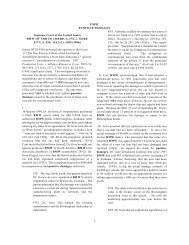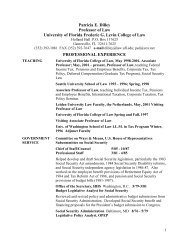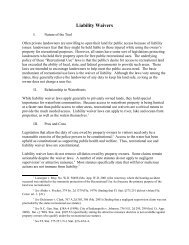The Shackling of The Shackling of Juvenile Offenders: Juvenile ...
The Shackling of The Shackling of Juvenile Offenders: Juvenile ...
The Shackling of The Shackling of Juvenile Offenders: Juvenile ...
You also want an ePaper? Increase the reach of your titles
YUMPU automatically turns print PDFs into web optimized ePapers that Google loves.
Not all <strong>of</strong> the pr<strong>of</strong>essionals involved with<br />
juvenile <strong>of</strong>fenders support a change to current<br />
shackling practices. While the DJJ does not have<br />
an <strong>of</strong>ficial policy regarding juvenile shackling during<br />
court proceedings, the DJJ and many Florida<br />
State Attorney’s Offices <strong>of</strong>ten maintain that shackling<br />
detained juveniles is a necessary safety measure.<br />
12 Proponents <strong>of</strong> continued shackling assert<br />
that unshackled juveniles present a flight risk, as<br />
well as a security risk to the judge, lawyers and<br />
other courtroom observers. 13<br />
<strong>Shackling</strong> proponents argue that young<br />
defendants are more impulsive than adults, and thus, juvenile <strong>of</strong>fenders may require tighter security<br />
practices than adults because they are more likely to run without considering the consequences <strong>of</strong><br />
their actions. 14 Detained children have already been determined to meet secure detention criteria,<br />
indicating that they pose a public safety risk. 15 Proponents further argue that shackling serves to<br />
deter further juvenile crime because detained children will see each other shackled. 16 Supporters <strong>of</strong><br />
juvenile shacking also assert that security in the court room is the sheriff’s responsibility. 17 <strong>The</strong>refore,<br />
the sheriff should be allowed to decide how best to secure the court room, not the judge. 18<br />
“This is humiliating for children to appear in a courtroom in front <strong>of</strong><br />
their families in an orange jumpsuit and shackles. I don’t understand<br />
why they have to do this.” David Perry, Assistant Public Defender,<br />
<strong>Juvenile</strong> Division, Second Circuit, FL<br />
Review Review <strong>of</strong> <strong>of</strong> <strong>Shackling</strong> <strong>Shackling</strong> Practices<br />
Practices<br />
<strong>The</strong> pivotal question in the shackling debate is whether the use <strong>of</strong> shackles is counterproductive<br />
to the goals <strong>of</strong> juvenile rehabilitation when the shackles are used during courtroom appearances<br />
regardless <strong>of</strong> alleged <strong>of</strong>fense or projected security risk. Unarguably, the rehabilitation <strong>of</strong><br />
children in the Florida juvenile justice system is a crucial goal <strong>of</strong> the state. <strong>The</strong> mission <strong>of</strong> the<br />
Florida DJJ is “to increase public safety by reducing juvenile delinquency through effective prevention,<br />
intervention and treatment services that strengthen families and turn around the lives <strong>of</strong> troubled<br />
youth.” 19 <strong>The</strong> goal <strong>of</strong> rehabilitating juvenile <strong>of</strong>fenders is also clearly expressed in the Florida<br />
Statutes Annotated §§985.01 and 985.02. 20<br />
In response to the ongoing debate and concerns from the Eighth Circuit judiciary about shackling<br />
practices, the Center on Children and Families (CCF) reviewed juvenile shackling practices and<br />
policies throughout Alachua County, the state <strong>of</strong> Florida and the United States. CCF also conducted<br />
observational research to evaluate the Eighth Circuit’s unshackling assessment. This report<br />
provides the results <strong>of</strong> CCF’s review.<br />
4

















